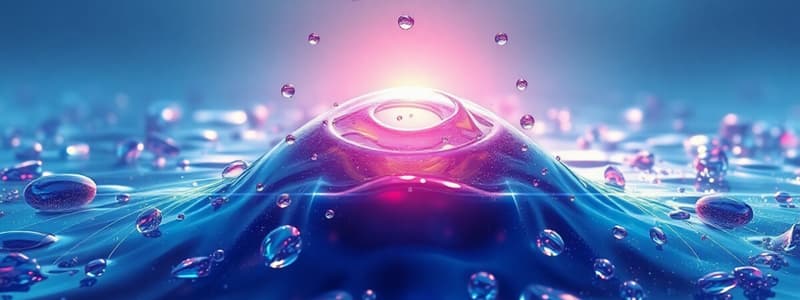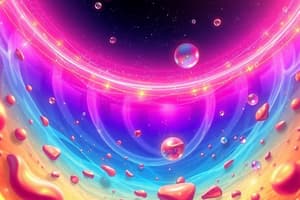Podcast
Questions and Answers
What property of the lotus leaf is primarily responsible for the Lotus Effect?
What property of the lotus leaf is primarily responsible for the Lotus Effect?
- Thickness of the leaf structure
- High transparency of the leaf
- Chemical composition of the leaf
- Surface roughness and hydrophobic properties (correct)
When analyzing the shape of a drop placed on a sample surface, which method is NOT mentioned as a valid analysis technique?
When analyzing the shape of a drop placed on a sample surface, which method is NOT mentioned as a valid analysis technique?
- Ultrasonic measurement (correct)
- Visual inspection by eye
- Photographic analysis
- Using a high resolution camera
Which of the following best describes the movement of water drops on a lotus leaf?
Which of the following best describes the movement of water drops on a lotus leaf?
- They evaporate quickly
- They form puddles on the surface
- They roll over dirt particles (correct)
- They absorb into the leaf
What measurement is used to understand the hydrophobic properties of surfaces in the contact angle experiment?
What measurement is used to understand the hydrophobic properties of surfaces in the contact angle experiment?
What results from the different microstructures on the lotus leaf?
What results from the different microstructures on the lotus leaf?
What term is used for surfaces that attract water molecules, resulting in liquid dispersion?
What term is used for surfaces that attract water molecules, resulting in liquid dispersion?
What results from a weak interaction between liquid molecules and a solid surface?
What results from a weak interaction between liquid molecules and a solid surface?
What does a large contact angle between a liquid and a solid indicate?
What does a large contact angle between a liquid and a solid indicate?
Which of the following correctly describes the behavior of a liquid as characterized by contact angle?
Which of the following correctly describes the behavior of a liquid as characterized by contact angle?
How is the degree of wetness of a mineral quantified?
How is the degree of wetness of a mineral quantified?
What happens to the contact angle as the cohesive forces among liquid molecules increase compared to adhesive forces?
What happens to the contact angle as the cohesive forces among liquid molecules increase compared to adhesive forces?
Which of the following best describes the role of contact angle in surface analysis?
Which of the following best describes the role of contact angle in surface analysis?
What is the contact angle measured against when observing a solid surface?
What is the contact angle measured against when observing a solid surface?
What role does wetting play in mineral processing methods such as flotation?
What role does wetting play in mineral processing methods such as flotation?
Which factor is essential for effective flotation of a mineral?
Which factor is essential for effective flotation of a mineral?
Which mineral is likely to be classified as hydrophobic and suitable for flotation?
Which mineral is likely to be classified as hydrophobic and suitable for flotation?
What is one of the primary purposes of adding collectors in the flotation process?
What is one of the primary purposes of adding collectors in the flotation process?
What equipment is primarily used for measuring contact angles?
What equipment is primarily used for measuring contact angles?
How does a large contact angle affect the flotation of a mineral?
How does a large contact angle affect the flotation of a mineral?
Which contact angle measurement method involves observing a liquid drop on a solid surface?
Which contact angle measurement method involves observing a liquid drop on a solid surface?
Why is it important for non-wetting particles to attach to air bubbles in flotation?
Why is it important for non-wetting particles to attach to air bubbles in flotation?
What is the maximum flotation recovery achieved with sufficient amine concentration?
What is the maximum flotation recovery achieved with sufficient amine concentration?
What is the contact angle associated with high flotation recovery?
What is the contact angle associated with high flotation recovery?
What occurs when there is excessive amine concentration?
What occurs when there is excessive amine concentration?
At which concentration of DAH is no flotation observed?
At which concentration of DAH is no flotation observed?
Which situation describes having a high flotation recovery?
Which situation describes having a high flotation recovery?
What is the flotation recovery percentage when the contact angle is 0 degrees?
What is the flotation recovery percentage when the contact angle is 0 degrees?
What is the expected flotation recovery with a contact angle near 70 degrees?
What is the expected flotation recovery with a contact angle near 70 degrees?
Which concentration range of DAH results in high flotation recovery?
Which concentration range of DAH results in high flotation recovery?
What does a contact angle between 0 and 30 degrees indicate about a solid surface?
What does a contact angle between 0 and 30 degrees indicate about a solid surface?
Which of the following statements about contact angles is true?
Which of the following statements about contact angles is true?
What is contact angle hysteresis primarily related to?
What is contact angle hysteresis primarily related to?
If a liquid on a mineral displays a contact angle of around 90 degrees, what can be inferred about the mineral?
If a liquid on a mineral displays a contact angle of around 90 degrees, what can be inferred about the mineral?
Which factor does NOT influence the contact angle on a mineral surface?
Which factor does NOT influence the contact angle on a mineral surface?
What is an example of a hydrophilic surface characteristic?
What is an example of a hydrophilic surface characteristic?
What is the effect of molecular dynamics simulation on contact angles?
What is the effect of molecular dynamics simulation on contact angles?
Which contact angle range indicates a surface is partially wettable?
Which contact angle range indicates a surface is partially wettable?
What is the contact angle for a DAH concentration of $2.10^{-3}$ M?
What is the contact angle for a DAH concentration of $2.10^{-3}$ M?
Which DAH concentration results in the highest flotation recovery?
Which DAH concentration results in the highest flotation recovery?
At which DAH concentration does flotation recovery begin to significantly decline?
At which DAH concentration does flotation recovery begin to significantly decline?
Identify the contact angle corresponding to a DAH concentration of $5.10^{-6}$ M.
Identify the contact angle corresponding to a DAH concentration of $5.10^{-6}$ M.
What contact angle is observed at a DAH concentration of $5.10^{-4}$ M?
What contact angle is observed at a DAH concentration of $5.10^{-4}$ M?
What trend is observed in contact angle as DAH concentration increases?
What trend is observed in contact angle as DAH concentration increases?
What is the flotation recovery percentage at a DAH concentration of $1.10^{-4}$ M?
What is the flotation recovery percentage at a DAH concentration of $1.10^{-4}$ M?
Which of the following concentrations gives a contact angle closest to 40°?
Which of the following concentrations gives a contact angle closest to 40°?
What is the flotation recovery percentage at the lowest concentration of $1.10^{-6}$ M?
What is the flotation recovery percentage at the lowest concentration of $1.10^{-6}$ M?
What is the observed flotation recovery at a DAH concentration of $2.10^{-4}$ M?
What is the observed flotation recovery at a DAH concentration of $2.10^{-4}$ M?
For a DAH concentration of $1.10^{-3}$ M, what is the contact angle?
For a DAH concentration of $1.10^{-3}$ M, what is the contact angle?
How does flotation recovery change from $1.10^{-6}$ M to $1.10^{-5}$ M?
How does flotation recovery change from $1.10^{-6}$ M to $1.10^{-5}$ M?
At a DAH concentration of $2.10^{-2}$ M, what is the flotation recovery percentage?
At a DAH concentration of $2.10^{-2}$ M, what is the flotation recovery percentage?
Flashcards
Contact Angle
Contact Angle
The angle formed between a liquid surface and a solid surface when a liquid is placed on the solid.
Hydrophilic Surface
Hydrophilic Surface
A material that allows a liquid to spread across its surface. This happens when the attraction between the liquid and solid is stronger than the attraction between liquid molecules.
Hydrophobic Surface
Hydrophobic Surface
A material that resists the spread of a liquid. The attraction between the liquid molecules is stronger than the attraction between the liquid and solid.
Cohesion Forces
Cohesion Forces
Signup and view all the flashcards
Adhesion Forces
Adhesion Forces
Signup and view all the flashcards
Wettability
Wettability
Signup and view all the flashcards
Surface Free Energy
Surface Free Energy
Signup and view all the flashcards
Contact Angle Measurement
Contact Angle Measurement
Signup and view all the flashcards
Young's Equation
Young's Equation
Signup and view all the flashcards
Contact Angle Hysteresis
Contact Angle Hysteresis
Signup and view all the flashcards
Effect of Roughness on Contact Angle
Effect of Roughness on Contact Angle
Signup and view all the flashcards
Effect of Heterogeneity on Contact Angle
Effect of Heterogeneity on Contact Angle
Signup and view all the flashcards
Lotus Effect
Lotus Effect
Signup and view all the flashcards
Super Hydrophobic surface
Super Hydrophobic surface
Signup and view all the flashcards
Hydrophobic Coating
Hydrophobic Coating
Signup and view all the flashcards
Self-cleaning surface
Self-cleaning surface
Signup and view all the flashcards
Hydrophobic mineral
Hydrophobic mineral
Signup and view all the flashcards
Hydrophilic mineral
Hydrophilic mineral
Signup and view all the flashcards
Flotation
Flotation
Signup and view all the flashcards
Collector
Collector
Signup and view all the flashcards
Buoyancy force
Buoyancy force
Signup and view all the flashcards
Gravity force
Gravity force
Signup and view all the flashcards
Cohesion
Cohesion
Signup and view all the flashcards
Adhesion
Adhesion
Signup and view all the flashcards
Dodecylamine Hydrochloride (DAH)
Dodecylamine Hydrochloride (DAH)
Signup and view all the flashcards
Flotation Recovery
Flotation Recovery
Signup and view all the flashcards
Correlation of Quartz-Amine Adsorption / Contact Angle / Flotation
Correlation of Quartz-Amine Adsorption / Contact Angle / Flotation
Signup and view all the flashcards
Insufficient DAH Concentration
Insufficient DAH Concentration
Signup and view all the flashcards
Low Contact Angle and Flotation Recovery Range
Low Contact Angle and Flotation Recovery Range
Signup and view all the flashcards
Surface Modification
Surface Modification
Signup and view all the flashcards
Quartz
Quartz
Signup and view all the flashcards
Mineral Processing
Mineral Processing
Signup and view all the flashcards
What is the relationship between amine concentration and contact angle?
What is the relationship between amine concentration and contact angle?
Signup and view all the flashcards
What is quartz-amine flotation?
What is quartz-amine flotation?
Signup and view all the flashcards
What is the effect of a low amine concentration on quartz-amine flotation?
What is the effect of a low amine concentration on quartz-amine flotation?
Signup and view all the flashcards
What happens when you use an excessive amine concentration in quartz-amine flotation?
What happens when you use an excessive amine concentration in quartz-amine flotation?
Signup and view all the flashcards
What is the contact angle?
What is the contact angle?
Signup and view all the flashcards
What does the contact angle tell us about wettability?
What does the contact angle tell us about wettability?
Signup and view all the flashcards
Why is the contact angle important in quartz-amine flotation?
Why is the contact angle important in quartz-amine flotation?
Signup and view all the flashcards
Why is a low contact angle a problematic factor in quartz-amine flotation?
Why is a low contact angle a problematic factor in quartz-amine flotation?
Signup and view all the flashcards
Study Notes
Surface and Colloid Chemistry
- Deals with properties of solid-liquid interfaces and surfaces, specifically contact angles.
- Examines how liquids behave on solid surfaces, either dispersing or forming drops.
- The contact angle, formed between the liquid surface and the solid, is influenced by the cohesive forces within the liquid and adhesive forces between the liquid and the solid surface.
- Hydrophilic surfaces exhibit strong liquid-solid interactions, resulting in complete liquid dispersion. Water-loving.
- Hydrophobic surfaces have weak interactions, leading to droplets. Water-repellent.
- Contact angle size depends on the balance of attraction forces (cohesion and adhesion) between molecules in the liquid and between the liquid and the solid.
- Larger contact angles signify weaker solid-liquid attraction, while smaller angles indicate stronger attraction.
- Wettability, a measure of how well a solid surface can be wetted by a liquid, is determined by the contact angle.
- Contact angles between 0-30 degrees are considered wettable, 30-89 degrees partially wettable, and greater than 90 degrees non-wettable.
Molecular Dynamics Simulation (MDS)
- Used to simulate the behavior of a liquid drop on hydrophilic and hydrophobic surfaces.
- Simulations illustrate different wetting behaviors on these surfaces. Hydrophilic surfaces result in drops spreading, while hydrophobic surfaces result in drops forming spherical shapes.
Contact Angle and Flotation
- Wetting of minerals is a key parameter in mineral processing (e.g., flotation).
- Flotation separates minerals based on their hydrophobicity or hydrophilicity.
- Hydrophobic minerals tend to attach to air bubbles, allowing for separation from hydrophilic minerals.
- A greater contact angle often equates with improved flotation recovery. Higher contact angles will aid in separating hydrophobic materials from the rest.
- Chemicals (collectors) can alter mineral surface properties to control the contact angle.
- The buoyancy of the air bubble needs to be greater than the gravity force affecting the mineral.
Lotus Effect
- Lotus effect is based on surface roughness and hydrophobic properties.
- Lotus surfaces demonstrate self cleaning.
- Water droplets roll off, carrying dirt and debris along with them, due to the hydrophobic nature.
Contact Angle Measurement Methods
- Goniometry is an optical tensiometer used to measure contact angles (simplest method)
- Various techniques such as sessile drop, sessile bubble, captive bubble, and tilting plate methods are utilized for contact angle measurements.
- The shape of the drop, formed on the surface, can be evaluated visually, or captured via high-resolution camera photographs.
Θeta Optical Tensiometer
- Provides several measurements including contact angles and pendant drop analysis.
Advancing and Receding Contact Angles
- Contact angles can differ depending on whether the liquid is advancing or receding.
- Advancing contacts are larger, while receding are smaller than the average contact angle.
Effect of Roughness and Heterogeneity
- Roughness and heterogeneity in mineral surfaces can affect contact angles.
- Different chemical groups can exist on a surface, impacting wettability.
Contact Angles of Selected Substances
- A table lists contact angles for diverse substances, such as PTFE and metals like gold, silver.
Contact Angle Experiment
- Studies contact angles relating to DAH concentration on quartz samples
- Experimental data tables show contact angles measurements.
- Correlation exists between flotation recovery and contact angle variations with DAH concentration.
Lab 3
- Explores Contact Angle experiments.
- Scheduled for December 6, 2024 (9:00-11:20).
Studying That Suits You
Use AI to generate personalized quizzes and flashcards to suit your learning preferences.




